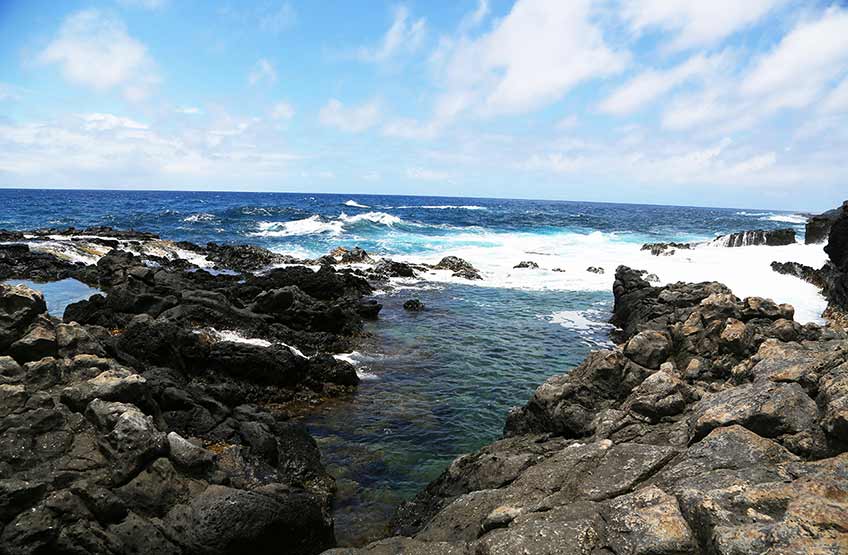Industry Innovators Take on Wave-Powered Desalination Challenge through DOE Prize Competition
Turning seawater into drinking water is a challenge for the ages—one that industry innovators are now embracing as competitors in the U.S. Department of Energy (DOE) Waves to Water Prize.
The competition invites participants to develop wave-powered desalination systems that can be deployed in disaster-relief scenarios and remote coastal locations to provide potable drinking water. DOE selected 20 teams as winners of the CONCEPT Stage of the prize.

Following pretreatment to purge the water of viruses, bacteria, salt, and sand, innovative desalination systems use the energy generated by waves to power desalination processes delivering potable water. Image courtesy of Deb Lastowka, NREL
“The breadth of innovation and the diversity of applicant backgrounds we’ve received highlight how much interest there is around desalination technologies,” said Scott Jenne, NREL’s principal investigator for the Waves to Water Prize.
Among the CONCEPT Stage winners are eight industry members with experience in either desalination or wave energy:
- Black & Veatch SurfBuoy: A point absorber wave energy converter (WEC), SurfBuoy consists of an inflatable buoy with a piston pump in a reverse-osmosis unit inside a container. SurfBuoy uses off-the-shelf options to reduce technical risk and can be manually deployed for coastal communities in disaster-relief efforts.
- Sea Potential DUO-Powered Waves to Water Project: Easy to construct and deploy, Sea Potential’s entry maximizes the amount of wave power that can be captured to provide high-pressure water for the desalination system and produce large volumes of high-quality potable water. The team’s DUO wave energy device captures wave power from several directions—including heave and pitch—at the same time.
- LifeSaver Emergency Survival Kit: Designed to supply electricity and fresh drinking water to lifeboats and life rafts in remote or disaster-affected areas, LifeSaver’s entry comprises a WEC, a commercially available GPS-enabled radio beacon, and a portable reverse-osmosis desalination system.
- Mirko Previsic MetaMorph H20: Featuring an inflatable, heaving, float-design anchor that drives a rotary winch, the MetaMorph H20 system synchronizes the float and reverse-osmosis system with the gearbox. This scalable system can achieve a continuous power output range between 200 watts and 2 kilowatts.
- MarkZero MZSP Freshwater Production System: A wave attenuator with an onboard reverse-osmosis system, the MZSP power system consists of three subsystems—a WEC that produces high-pressure seawater, a reverse-osmosis system that converts the seawater to 50–100 liters of freshwater per hour, and a control system that enables the two systems to work together.
- Oneka Novel Compact Wave-Powered Watermakers: Designed to install easily and operate in harsh ocean environments with multiple wave conditions, Watermakers are point-absorber desalination buoys that feature a reverse-osmosis system and a direct-acting pump.
- RME USA Pytheas Point Absorber with Piezo PTO: Deployed at the surf zone and producing electricity to power a commercial off-the-shelf seawater reverse-osmosis system, the Pytheas Point Absorber provides fresh water to disaster areas. The system features Piezoelectric actuators that transform the motion of the waves into electricity and send it to shore, where it is used to drive an off-the-shelf desalination system.
- Ballast, Buoys, and Borrowing from Archimedes: Project 816 Team leverages the vertical movement of ocean waves to power a series of hydrokinetic turbine generators using a floating buoy attached to a rope-and-pulley system. The system is lightweight for rapid deployment and uses commercial, off-the-shelf modular components.
In addition to the competitors selected in the CONCEPT Stage, the International Desalination Association (IDA) is collaborating with DOE on the Waves to Water Prize. Industry members within the IDA are working to incorporate renewable energy into the mix of desalination solutions as well.
“The IDA and our members are looking at initiatives that will make the desalination process more sustainable to decrease its environmental impact,” said IDA Secretary General Shannon McCarthy. “DOE’s active role in promoting wave-powered desalination is of keen interest to our industry members, some of whom may participate in the Waves to Water Prize.”
This collaboration of investment, research, and innovation from DOE and industry is helping meet the age-old challenge of turning seawater into drinking water using the power of waves. Winners of the Waves to Water Prize DESIGN Stage will be announced soon.
Last Updated May 28, 2025
